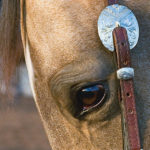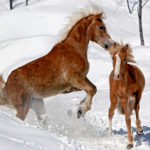Can a horse hair whorl tell you anything you don’t already know about your horse’s temperament? Or help you predict the behavior tendencies of a prospect you’re thinking of buying?

Bedouins in Arabia thought so, hundreds of years ago. So did European gypsies, famed for their close bond to horses. Even some of America’s “old time” horsemen of the 1940s and ’50s put a fair bit of stock in horse hair whorl analysis.
But–in modern times?
Surprisingly, the answer is yes. Since the pioneering work of author and educator Linda Tellington-Jones in the 1960s, ’70s, and ’80s, the interest in using horse hair swirls, or horse hair whorls, to evaluate disposition has been gradually gaining adherents. Now there’s even some science to back up the notion that outward characteristics such as hair swirls are linked in fundamental ways to inward characteristics such as temperament.
In this article, we’ll share a little of the history of swirl analysis, relate a few anecdotes and opinions, and look at a relevant study on swirls and temperament. We’ll also touch on the predictive value of such other physical characteristics as body traits and coat color, plus consider what’s been found to be true in other species.
After that, you can go out to the barn, examine your own horse, and decide for yourself how much of a book you can tell by its cover.
What Is A Whorl?
A whorl or swirl is a patch of hair growing in the opposite direction of the surrounding hair, usually in a pinwheel fashion. It’s commonly found on the head, and especially the face. Whorls are also known as trichoglyphs, or cowlicks when they appear elsewhere on the body.
Because every horse’s whorls are distinctive, like a fingerprint, recording their location and character is one of the oldest forms of identifying horses–especially those without white markings.
But these days, that’s not all they’re used for. Ask Doug Carpenter, whose reputation for picking future winners is well established in the performance horse world. The Sulphur, Oklahoma, horseman has bought or sold such standout individuals as Boomernic, 1992 National Reining Horse Association Futurity champion; Smart Zanolena, 1999 National Reined Cow Horse Association Futurity champion; and Chics Magic Potion, 2003 NRCHA Futurity champion. His client list includes the likes of Clinton Anderson, Bob Avila, Shawn Flarida, Benny Guitron, Dell Hendricks, and Tim McQuay.
He’s clearly the real deal, and one of his criteria for evaluating prospects is hair swirl patterns.
“I started looking at them years ago out of curiosity, then narrowed it down to a system that works for me,” he says, noting that his ideal combination–in terms of indicating the likelihood of a willing, trainable prospect–is one swirl centered on the forehead between the eyes, and two matching swirls on either side of the bridle path, “not extending beyond the length of the ears when they’re folded back.”
He adds that in some lines of horses, a single swirl centered below the level of the eyes is also a positive indication, and two swirls close together can be OK–“though not in all instances,” he cautions. “It’s like every other theory–not 100 percent.”
By contrast, if a horse has two or more swirls that are relatively spread apart on the face, “I’m a little concerned,” he says. Though swirls are an important consideration in Carpenter’s evaluations, they’re not necessarily a make-or-break proposition. “If I really like a horse but his swirls don’t line up the way I prefer, it’s not a crucial deal,” he explains. “But if a horse is already questionable, and I haven’t really locked in and committed to him mentally, and his swirls are all out of line, it pretty much rules that horse out.” That’s how one modern and highly successful horseman makes use of swirls, and though he’s tailored his method for his own purposes, he’s following in a well-established tradition.
Swirls ‘Back Then’
The practice of using hair swirls as predictors of a horse’s temperament and usability dates back centuries among gypsies and Bedouins. It was in the 1980s and ’90s, however, that it became popularized through the books and clinics of Linda Tellington-Jones. In 1965, before the horsewoman had established her now-famous “equine awareness method,” she analyzed the results of a questionnaire sent to horse owners; the survey netted observations on the swirl patterns and behavior characteristics of 1,500 horses.
Tellington-Jones’ resulting breakdown of swirl patterns and their relationship to personality traits is detailed and specific. In general, however, she found that a single swirl in the center of the forehead indicated an uncomplicated nature; a single swirl centered below the level of the eyes indicated an intelligent, possibly mischievous nature; a single, long swirl between or extending below the eyes indicated an especially friendly, agreeable nature; and two or more swirls generally indicated a more complicated personality in some way. (For more detail on her analyses, see Getting In TTouch: Understand and Influence Your Horse’s Personality, Trafalgar 1995; www.EquineNetworkStore.com.)
Tellington-Jones has consistently stressed that the best use of swirl analysis is in discovering how best to approach a particular horse’s training.
“If a horse’s swirls tell you he’s the more temperamental type, then you know not to get after him for ‘attitude,’ as that will just upset him more,” she says. “Many of my top horses had two swirls. Nowadays we have so many more ways to deal with such horses–to teach them to think instead of react.”
More Swirl Studies
The validity of swirl analysis took a huge step forward early in this decade with the work of animal scientist Temple Grandin, PhD, of Colorado State University. She became interested in swirls when her assistant, Mark Deesing, who trains and shoes horses, shared his casual observation that horses with swirls high on the forehead, or two swirls, tended in general to be more reactive and “high strung.”
Grandin and Deesing decided to see if these correlations held up under scrutiny. They opted to work with cattle, as they needed a large number of animals without extensive handling so the results wouldn’t be influenced by training. (Cattle also have whorl patterns similar to horses’.) Working at a Colorado feedlot, they observed 1,500 cattle as they were restrained, one at a time, in a hydraulic squeeze chute for vaccinations. One person noted the animal’s whorl patterns while the other, positioned so the facial swirls weren’t visible (to avoid bias), ranked the animal’s temperament using a standardized scale.
“We found there was definitely a relationship between the position of whorls and the temperament of the cattle,” reports Grandin. “Those with swirls high on the forehead were more likely to fight and move around in the chute. And we’ve definitely observed enough of the same sort of correlation in horses to know it’s a factor for them, as well.
“With horses, I think sometimes people read too much into it in terms of personality,” she adds. “How easily the animal gets scared–that’s how I prefer to put it.”
However you put it, it begs the question: Why should hair swirls and temperament be connected in any way? As it turns out, hair swirl patterns form in the developing fetus at the same time the brain is forming.
“The nervous system and the skin, which contains the whorl patterns, come from the same embryonic layer,” explains Grandin. “This may explain the apparent relationships between body traits and temperament.” (See “Beyond Horses: Humans, Rats, & Foxes,” below.)
Like Tellington-Jones, Grandin stresses that the most important use of swirl analysis in horses is as a guide in training.
“I’m not a fan of rough training methods in general, but if you use them on a high-whorl individual, you’ll probably traumatize and wreck that animal,” she says. “You also need to be especially careful not to frighten a horse with high whorls. That’s the key in horse training, anyway–to avoid traumatizing the animal in the first place.”
Not So Fast…
Though it’s all very interesting, not everyone buys into “swirl theory.” Trainer Benny Guitron, who’s showed more than his share of champions and is a popular broker for the buying and selling of horses, is skeptical.
“I don’t know that much about it, so I’ve never used swirls as a guideline in purchasing a horse or figuring out behavior,” he says. “I’m much more concerned with the softness in the eye to tell me what a horse will be like. My father used to look at swirls,” he adds, “but I never saw him pass up a good horse if a swirl wasn’t in the right place.”
Likewise, Team H&R member and world-champion trainer Bob Avila is equivocal.
“I’m not sure I’ve been able to prove it one way or the other,” he says of the predictive value of swirls. “I grew up hearing about the importance of having one in the middle of the fore- head, not too high or too low, but I’ve had some good horses with ‘bad’ swirls, and bad horses with ‘good’ ones.”
Still, the trainer allows as how his experiences showing cattle in high school seemed to benefit from swirl analysis. Horseman George Smith, who owned a lot of great Doc Bar offspring, always hand-picked Avila’s steers for him on the basis of swirls. “He was really into that,” Avila admits.
Moreover, the anecdotal information on swirls is to be found everywhere once you start asking around. Anne Marie “Bubbles” Hiller coached riders on the open Western circuit on the West Coast in the 1970s; today she’s a well-respected judge for the United States Equestrian Federation in the open Western and Arabian horse divisions. She’s convinced swirls are linked to behavior.
“I first starting noticing swirls after a trainer friend mentioned them about eight to 10 years ago, when we were both at a show in Reno,” she recounts. “She told me she’d observed that the horses that were nutty–flighty and hard to clip–were the ones with cowlicks all over.
“Since I started paying attention, I’ve found that horses with swirls dead-centered on the forehead or just slightly below–plus not a lot of cowlicks over the rest of the body–just seem to be easiest to work with. It pretty much holds up. People tend not to notice until you point it out to them, but once you do…”
In The Final Analysis…
So, what to make of all this? Even those who believe in a link between physical characteristics, such as hair swirls, and temperament caution against putting undue stock in it. Genetics expert Phillip Sponenberg, DVM, PhD, of the Virginia-Maryland Regional College of Veterinary Medicine sums it up well.
“It’s not outside the realm of possibility that there’s a relationship here,” he says, noting again the similar embryonic origins of skin/hair and the brain. “That said, it appears to be ‘loose’ enough that while it might be broadly predictable, the fine details in individual variation overwhelm it in many cases.
“So, due to individual variation, it ‘works’ some of the time but not all of the time.”
Which, if you start paying close attention to hair swirls, you’ll find to be absolutely true.
Beyond Swirls: Body Shapes & Hair Colors
Hair swirls aren’t the only physical characteristic believed to be linked to temperament. In her research, Temple Grandin has also noticed a correlation between body shape/size, bone structure, and temperament.
“With many different animals–horses, cattle, dogs, even wild species–you find that the smaller, more fine-boned and slender animals tend to be flightier,” she says. “Think of Arabians vs. draft horses; greyhounds vs. St. Bernards; antelope vs. elephants.
“We measured this specifically in cattle, and the ones that tended to race out of the squeeze chute had leg bones that were smaller in diameter than the quieter ones.”
Linda Tellington-Jones also finds links between temperament and the various characteristics of a horse’s head. “The shape of the face, set of the ears, line of the jaw–all these are indicators of temperament, totally apart from breed differences,” she says, noting for example that a horse with broad ears set far apart tends to be the dependable, cooperative type. Plus, “the straighter the profile, the more honest the horse will be.”
Even coat color may, in an extremely general way, be related to broad temperament categories. Tellington-Jones believes chestnut mares are “more nervy,” for better or worse, and that black horses tend to be especially sensitive. “The most reliable horses are often bay,” she says. “They tend to be even-tempered and less problematic in many ways.”
Doug Carpenter says he’s noticed for his part that blacks and grays seem to be “a little tougher to train than horses of other colors, though I still buy them because people want them.
“The black ones do seem to last longer when you do get them trained,” he adds. “They have great longevity.”
And as for bays? “They tend to be good, solid-minded horses as a general rule.”
Beyond Horses: Humans, Rats & Foxes
Though the notion we can know anything about a horse’s temperament from hair swirls or coat color seems old-wivesish on the face of it, there’s actually quite a bit of information available on the linkage between physical characteristics and behavioral characteristics in humans and other species of animals.
For example, Temple Grandin’s study on hair swirls in cattle also noted that:
- Children and adults with developmental disabilities have a high incidence of abnormal hair whorl patterns;
- Studies with guinea pigs have shown selecting for different hair colors changed the animals’ temperament;
- Studies with rats have shown that breeding for the black, non-agouti (non-ticked) coat color resulted in tamer, easier-to-handle rats;
- Studies with foxes found differences in temperament clearly linked to differences in coat color. Obviously, horses are not humans, rats, or foxes; still, the fact that these correlations are proven in other species may help explain some of the interesting things horsemen of old–and now today–have noticed about physical characteristics and temperament in horses.





